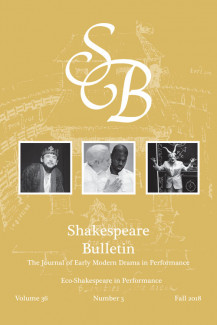
Johns Hopkins UniversityEst. 1876
America’s First Research University
Assessing Natural Shakespeare
How does Shakespeare relate to the environment? That's the question which a special issue of Shakespeare Bulletin last year tried to address. Guest editors Randall Martin from the University of New Brunswick and Evelyn O'Malley from the University of Exeter worked to put together a collection of essays examining how Shakespeare scholars and theater practitioners can make ecological relations and environmental politics a motivating concern of twenty-first century productions. Martin and O'Malley joined us for a Q&A on this special issue.
How did this collection of papers come together?
This collection developed first out of the need for a break-out. For the past dozen years or so, Shakespeare ecocritics have been showing how the playwright’s work represents and questions new exploitative uses of the natural world which emerged in the early modern period. These uses included technological advances, capitalized production, and consumer-oriented growth. They created environmental deficits that surged during the nineteenth-century Industrial Revolution and exploded in the twentieth century. In works such as The Tempest, Shakespeare also glimpses the future of imperialism’s world-wide degradation of material, human, and animal resources.

Almost all scholarship about Shakespeare’s notice of these changes has been historically focused and text-centred, rather than concerned with the staging Shakespeare’s proto-environmentalist insights for modern audiences and relating them to the crises they anticipate or analogize today. At the end of Randall's book Shakespeare and Ecology (OUP 2015), he called on Shakespeare ecocritics to think about putting Shakespeare in touch with contemporary audiences through eco-dramaturgy. Implicitly this means literary ecocritics engaging across disciplines with theatre practitioners and scholars.
To begin mobilizing this idea, Randall organized a research seminar on eco-Shakespeare in performance at the 2016 meeting of the Shakespeare Association of America in which Evelyn participated. Afterwards she suggested co-editing a group of essays on the subject for a special issue for Shakespeare Bulletin. We were very dedicated about finding contributors who would write about eco-dramaturgy, site-specific and outdoor performances, and local environmental conditions and challenges within the wider geopolitical contexts of today’s Anthropocene. We feel the smart and engaging work of our contributors successfully reflects these aspirations.
How natural is the connection of the environment and Shakespeare, considering that performance of his work is often connected to productions such as "Shakespeare in the Park?"
At the heart of environmental humanities research is a troubling notion of the “natural”– crucial at a time when so much of nonhuman nature is under attack from human exploitation and negligence. “Shakespeare in the Park,” as you mention it, is actually one great place to tease apart easy assumptions about the supposed opposition of culture and nature, precisely because it seems so strikingly present at first glance. Parks, for example (such as Windsor Great Park in The Merry Wives of Windsor) have historically represented nature, and seem to represent commendable human efforts to conserve it. And part of that effort is essential to preserve habitats and ecosystems. But we also are recognizing that park landscapes are anything but natural. They are interventions in nature that both repair human problems and distort real and unavoidable interrelationships with non-human nature. Likewise, Shakespeare is often seen as a signifier for a certain kind of Romantic nature-friendly culture. Yet the idea that there is a “natural” connection between Shakespeare’s pastoral plays such as As You Like It, or forest plays such as A Midsummer Night’s Dream, and environmentalism is something that needs to be picked apart and reconsidered. There is no simple or unmediated reciprocity between Shakespeare and nature. That is something we feel Shakespearian ecodramaturgy should be exploring to illuminate, in non-reductive and non-didactic ways, the causes of and remedies for the current crises of the Anthropocene.
How important was it to include an afterword that tied the essays together?
Essential, we thought, because the point of these essays was not an end, but an outward looking and inspirational model to future scholarly and theatrical collaboration. We were thrilled that Sharon O’Dair, who has continually advocated for present-day orientations in ecocriticism, was happy to write such an incisive and vibrant response to the essays.

It was the obvious choice. SB is the top-ranked journal in Shakespeare and early modern drama performance studies and has the greatest visibility in the field. It has the greatest potential to reach new scholars and practitioners, and to move eco-Shakespeare from the page to the stage, from the academy into the public sphere.
This particular area of criticism is still very young. How do you hope this issue advances the field?
There is huge scope for further research in this field; and many of our contributors are already engaged in new and exciting projects. We would love to see more intersectional work, cutting across gender, race, postcolonial, economic, and health studies, since environmental issues are so integrally linked with these concerns. When it comes to theatrical affects, there are empirical questions to address about how audiences actually respond to the performances they encounter. Furthermore, there are centuries of historical performances to recuperate for what they reveal about human relationships with material and theatrical environments. We hope that the special issue brings together some of the research already undertaken in this field, and that it starts new creative conversations and investigations, enabling more compelling and nuanced questions and solutions to emerge.


